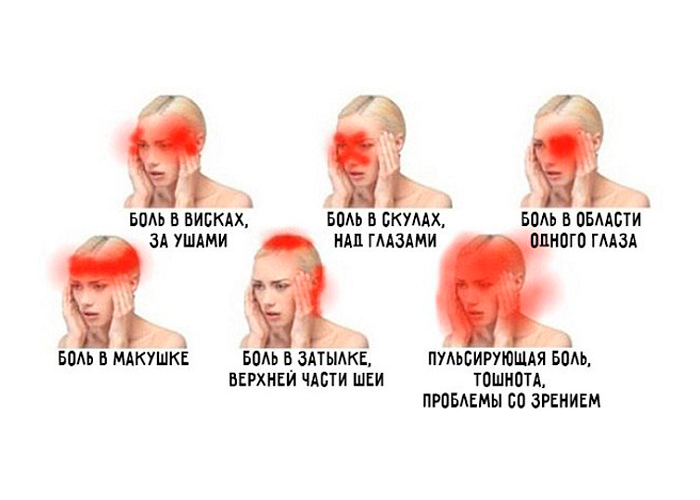What does the pain in different parts of the head say?

Headache (cephalalgia, from the Greek to the brain and pain) is one of the most common nonspecific symptoms of a variety of diseases and pathological conditions, which is pain in the head or neck area. Most often, the cause of the headache is vascular disorders associated with the expansion or spasm of the vessels inside or outside the cranium. This general clinical symptom should be distinguished from migraine, which is its particular case.
Headache is not a pain sensation of the nervous tissue of the brain, since there are no pain receptors in it. It arises due to the effect on the areas located in the head or neck 9, sensitive to pain: the skull (periosteum), muscles, nerves, arteries and veins, subcutaneous tissue, eyes, nasal sinuses and mucous membrane. The method of treating a headache depends on the identified disease or the cause of the onset of the symptom, in most cases, analgesics are prescribed.
Cluster headaches - pronounced pain syndrome in the areas of the projection of the brain on the walls of the cranium, arising spontaneously and irregularly. The strength of pain is so great that it can lead to suicidal attempts to get rid of pain.
Head-on tension type headache (tension-type headache) - since 1988, a new name, according to the nomenclature of the International Community for the Study of Headaches, what was formerly called the "headache tension" (tension headache). This is the most common form of primary headaches. With it, the pain can come from the vertex, occipital or parietal parts of the head, neck, eyes, forehead muscles, face and other muscle groups of the head, neck and face. Headache of the tensile type is approximately 90% of all headache cases.
Migraine (french migraine from other Greek-hemicrania hemicrania or "half of the head") is a neurological disease, the most frequent and characteristic symptom of which are episodic or regular severe and painful attacks of headache in one (rarely in both) half Head. In this case, there are no serious head injuries, stroke, brain tumors, and the intensity and pulsating nature of the pains are associated with a vascular headache, and not with a headache from tension. Headache with migraine is not associated with an increase or a sharp decrease in blood pressure, a bout of glaucoma or an increase in intracranial pressure. (ICP).
The head, the place that hurts periodically at all. Sometimes we ourselves are the culprits of this headache. A good party, alcohol, nicotine or something stronger, as you know, can spoil the whole morning and all the next day. But what to do when the pain appears out of nowhere? Headache, migraine and its other kinds, as if trying to tell us "Hey, slow down. I'm missing something ... ". In this article we will try to answer these questions.
1. Sudden and rapidly aggravated pain in the temples or in the crown
Such pain scares the most, because it appears suddenly and very quickly intensifies. It's like falling on you from above. On such a headache it is important to pay attention and consult a doctor, as it can be an indicator of many health problems, among which there is a subarachnoid hemorrhage that is fraught with human life.
2. Pain after injury
If you get a head injury, do not forget to see the doctor from time to time. Often, head injuries do not pass without a trace and may eventually manifest as frequent headaches.
3. Headache in the morning
If you wake up and feel terrible headache - this is a clear sign immediately to see a doctor. According to the National Institute of Neurology, such pain is a sure sign of serious health problems. This can be as high blood pressure, and nighttime apnea and even a brain tumor.
4. Pain in one eye or around it (cluster pain)
Cluster headache, it's a "suicidal headache", is so strong that many scientists believe that this is the most severe pain a person can experience.
5. Headache, which is accompanied by nausea, vision problems
Be sure to see a doctor if the headache is accompanied by changes in vision, nausea, irritation, neck pain, bad mood.
Brief memo
- If you feel pain in the cheekbones or over the eyes, then, perhaps, the cause of sinusitis.
- If you feel pain in the nape and upper part of the neck, then the problem may be in the neck (curvature, osteochondrosis).
- Migraines are characterized by throbbing pain, nausea, changes in vision.
- With increased pressure, the pain often seems to squeeze the head around the entire circumference.


Comments
When commenting on, remember that the content and tone of your message can hurt the feelings of real people, show respect and tolerance to your interlocutors even if you do not share their opinion, your behavior in the conditions of freedom of expression and anonymity provided by the Internet, changes Not only virtual, but also the real world. All comments are hidden from the index, spam is controlled.